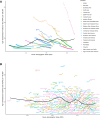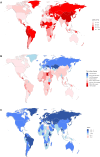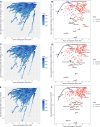Global, regional, and national trends in gastric cancer burden: 1990-2021 and projections to 2040
- PMID: 39726708
- PMCID: PMC11669584
- DOI: 10.3389/fonc.2024.1468488
Global, regional, and national trends in gastric cancer burden: 1990-2021 and projections to 2040
Abstract
Background: Gastric cancer (GC) is a common malignancy of the digestive system, with significant geographical variation in its disease burden.
Methods: This study used data from the Global Burden of Diseases, Injuries, and Risk Factors Study 2021 to analyze three key indicators: incidence, mortality, and disability-adjusted life years (DALYs). Initially, a detailed analysis of the GC burden was conducted from global, regional, national, gender, and age perspectives. Subsequently, the percentage change and average annual percent change (AAPC) of GC were calculated to understand the trends in disease burden. Decomposition analysis and frontier analysis were then performed. Finally, the Bayesian age-period-cohort model was used to predict the trends in age-standardized rates (ASRs) of GC up to 2040.
Results: In 2021, there were 1.23 million (95% UI: 1.05-1.41 million) new cases of GC globally, with 0.95 million (95% UI: 0.82-1.10million) deaths and 22.79 million (95% UI: 19.58-26.12 million) DALYs. Compared to 1990, the global ASRs of GC has declined, but new cases and deaths have increased. For females, age-standardized incidence rate, age-standardized mortality rate, and age-standardized DALYs rate were 8.6, 7.1, and 165.6 per 100,000, with AAPCs of -2.1, -2.4, and -2.6. For males, they were 20.9, 16.0, and 371.2 per 100,000, with AAPCs of -1.6, -2.1, and -2.3. ASRs fluctuated with increasing Socio-demographic Index (SDI), being higher in middle and high-middle SDI regions. Decomposition analysis indicated negative effects from epidemiological trends on GC burden, while population growth and aging had positive effects. Frontier analysis showed that middle and high-middle SDI regions had more potential for reducing ASRs. Predictions indicate a continued decline in ASRs for both genders by 2040.
Conclusion: Despite progress in controlling GC, the number of new cases and deaths globally is rising due to population growth and aging. This highlights the need for effective prevention and control strategies.
Keywords: disability-adjusted life years; gastric cancer; global burden of disease; incidence; mortality.
Copyright © 2024 Zhang, Zhang and Leng.
Conflict of interest statement
The authors declare that the research was conducted in the absence of any commercial or financial relationships that could be construed as a potential conflict of interest.
Figures







Similar articles
-
Global, regional, and national trends in colorectal cancer burden from 1990 to 2021 and projections to 2040.Front Oncol. 2025 Jan 16;14:1466159. doi: 10.3389/fonc.2024.1466159. eCollection 2024. Front Oncol. 2025. PMID: 39886660 Free PMC article.
-
Global, regional, and national burden of esophageal cancer: a systematic analysis of the Global Burden of Disease Study 2021.Biomark Res. 2025 Jan 6;13(1):3. doi: 10.1186/s40364-024-00718-2. Biomark Res. 2025. PMID: 39762900 Free PMC article.
-
Temporal trends of particulate matter pollution and its health burden, 1990-2021, with projections to 2036: a systematic analysis for the global burden of disease study 2021.Front Public Health. 2025 Apr 16;13:1579716. doi: 10.3389/fpubh.2025.1579716. eCollection 2025. Front Public Health. 2025. PMID: 40308905 Free PMC article.
-
Global, regional, and national burdens of early onset pancreatic cancer in adolescents and adults aged 15-49 years from 1990 to 2019 based on the Global Burden of Disease Study 2019: a cross-sectional study.Int J Surg. 2024 Apr 1;110(4):1929-1940. doi: 10.1097/JS9.0000000000001054. Int J Surg. 2024. PMID: 38215264 Free PMC article.
-
Global burden, risk factors, and projections of early-onset dementia: Insights from the Global Burden of Disease Study 2021.Ageing Res Rev. 2025 Feb;104:102644. doi: 10.1016/j.arr.2024.102644. Epub 2024 Dec 17. Ageing Res Rev. 2025. PMID: 39701185 Review.
References
LinkOut - more resources
Full Text Sources
Miscellaneous

